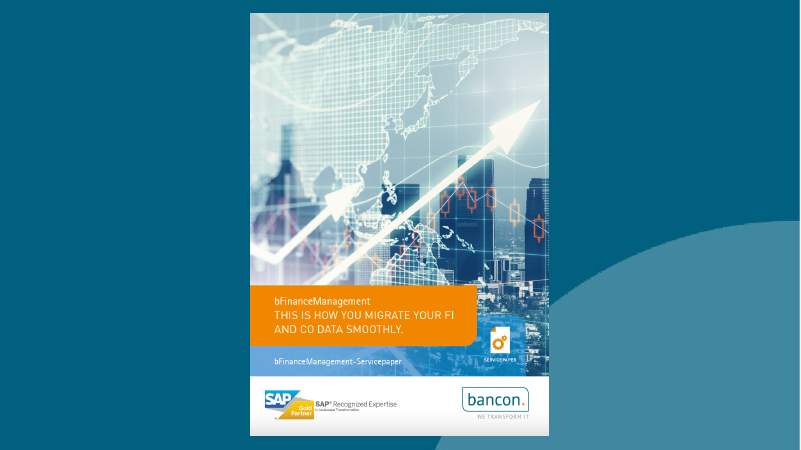- Services
Datentransformation
Transformation von Finanzdienstleistungen
Entwicklungsservices
- Kunden
- Über Uns
- Karriere
- Informationsmaterial
bMigrationEngine from bancon is a migration platform specifically designed from the ground up to facilitate migration events relating to SAP & SAP Fioneer applications.
We sat down with the Product team Karl-Heinz Eberl, Technical Product Owner and Tomas Kovac, Senior Development Architect, to find out more about bMigrationEngine and how it works in Data Migration projects.
Thank you for joining us, how did you both come to work for bancon?
Karl-Heinz starts, “I started out my career studying meteorology. I first worked as a developer in an insurance company. Then at the beginning of 2007, I joined bancon as a developer for SAP ERP systems. In 2009 I then moved over to SAP Banking services, where I started to specialise in financial services industry migrations. Over time I developed a real passion for migration projects, as the complexity appealed to me – and I am now responsible for the technical elements of our migration proposition including development and tooling. Since 2021, I have been the responsible product owner of bMigrationEngine.
“I started out in my career in a wide range of roles,” says Tomas “from Software Development, Architect and Project Lead. I’m a techy at heart! The topics I work on are mostly data migration, SAP system monitoring, SAP and non-SAP environment integrations, and R&D”. He says. ”I joined bancon in 2021 because I was interested in their product strategy and after seeing the earlier vision for their migration engine it seemed like a no brainer. I joined early enough in the process where I could really make my mark and apply my experience’’.
That’s great. So, what recent projects have you worked on at bancon?
“One of my latest projects has been with Rabobank,” says Karl-Heinz “We’re migrating from an old legacy system to SAP Banking Services. I started the project in 2015 and during this time, we’ve successfully executed several go-lives for critical propositions including Business Loans, Collaterals and Credit Limits. At the moment we are starting to migrate consumer loans which is a fundamental part of their tech-stack.”
Tomas says, “Since I joined bancon two years ago, I’ve been leading development activities on our in-house tools such as bMigrationEngine, and our bAutomation solution and other things we are building. From time to time I’m helping colleagues with their projects, usually when they are running into problems, have technical issues with the toolset they are using or to improve performance”
Why was bMigrationEngine developed?
“Our company was founded as being a centre of excellence for ‘‘SAP Data Landscape Transformation’; migrations, data carve ours, system consolidations and system harmonization. While this is now one of several service proposition now, migrations still make up a large portion of our global offering.” Says Karl-Heinz.
‘’During this time, we’ve developed a proven migration offering spanning methodology and approach, however, was always restricted by the migration platform which was owned by a 3rd party and limited in its abilities. “Back in 2021 the team sat down and discussed developing our own tool. “We wanted to create something that bancon would own and could develop with new technologies to improve productivity and efficiency. Ultimately, we wanted to be masters of our own destiny.
Because we knew what the pain points were using other platforms, we knew that one of the most important features of our platform was to make sure it was easy to use.”
“That’s right,” adds Tomas.
“Data Migration is one of our biggest service offerings, so we wanted to make sure we were always delivering the best service to our clients. It was the right time to invest in a data migration platform we owned without relying on other suppliers. This way we’re not restricted by what we can or cannot do or any licensing limits.” He says.
“The idea that we could fully shape a tool to suit the requirements of our clients was a no-brainer.”
Amazing! So, how does it work in a project?
‘‘A migration is much more than moving data from A to B and needs to be seen as the enabler to true transformation. Before we even start to consider the technical unpinnings first, we start by working closely with business and program stakeholders to define a realistic and tangible migration strategy to align respective risk appetite, downtime windows and timelines. Once defined, the technical element, including bMigrationEngine comes into play’’.
“At the beginning of a migration project, we will implement the platform into the client’s systems and start to configure settings according to the defined blueprint. bMigrationEngine supports the end-2-end migration process starting from extract, transformation and load but is often used in conjunction with other tools and therefore may only cover a specific area; Load only as an example. bMigrationEngine comes packed with a series of ‘‘out-of-the-box’’ templates or libraries that helps us to develop the migration objects quicker so that we can speed up the entire set-up process, and clients can leverage effort that has already been invested before.”
“From there, our Functional Analysts start working closely with business teams to define transformation or mapping logic based on the data sets provided and that what exists within the SAP solutions being migrated into – Migration Engine then applies this logic to automate and scale efficiency. Because of the easy-to-use nature of the platform, a functional consultant can manage most of the process without the need for developer intervention. Where deltas do exist, functional analysts engage with us, the development team, and collectively we will define technical specifications to close the gaps. We can then help to fully customise the tool based on the client’s requirements. Functional Analysts have the ability to complete the majority of the work required, customisations and technical changes will mean that migration developers can assist.”
“Once mapping logic is complete, we then turn our focus to the load element of the migration event. Here bMigrationEngine loads data in the SAP application, identifying errors and enabling error handling from built in root cause analysis. Assuming technical mapping is complete, we then start on the most critical part of the event – testing!
“Extremely oversimplified, but it highlights the criticality of having bMigrationEngine available.” Says Tomas.
“Since day one, we have tried to adopt the “no-code”/”low-code” approach with the user experience, so there is a lot you can achieve with the tool without extra custom development. However, with the competent developer on the team, they can go crazy with the custom additions and extensions and customize the software to do practically anything..” He continues.
What are the benefits of bMigrationEngine?
“Well, like already mentioned” starts Karl-Heinz, “we often don’t need to start from scratch.”
“From the beginning, we always wanted to ensure clients had access to a library of content, or templates, where they could leverage work that has been performed before. The library of templates allows us to improve performance and speed, which ultimately brings cost benefits to our clients. It also allows us to build specific industry-focused libraries, for example, bMigrationEngine - Banking Edition which enables financial institutions to deploy ‘‘out-of-the-box’’ migration content almost immediately.
“I would say flexibility and performance are the two standout benefits of bMigrationEngine.” Adds Tomas.
“So much effort has been put into providing flexibility ‘out of the box’ – flexibility brings options, and options allow us to adapt during time of challenge. We also understand how much performance matters, especially when you are working through or with a lot of data. The tool certainly takes quite a modern approach to migration. Of course, the more complex the migration is the longer the process will take, but, the things that can slow the process down are well known, documented and can be planned with or worked around to ensure efficiency.”
And what’s next for bMigrationEngine?
“The outlook for future projects is that we’ll have a growing library of predefined, almost-ready content. This way we won’t need to start from scratch on migration objects, allowing clients to leverage best practise in the meanwhile. We will have a head start in completing migrations – allows us to focus on the more complex tasks.” Says Tomas.
Karl-Heinz adds, “We will always have custom-specifics. But with pre-loaded templates, we can speed up the migration times through our standardised content.”
“The tool is in continuous development. We will continue to make improvements to bMigrationEngine over time but the tool as it stands today is different to everything else that is on the market. I’m really proud of what’s been delivered to date, and feedback from our clients that are utilising bMigrationEngine has been amazing.” He continues.
And finally, what would you say to someone joining bancon?
“What would I say to someone looking to join bancon after 16 years?” Karl-Heinz asks.
“I would say, anyone looking to work with experienced professionals and international teams that are made up of down-to-earth people should consider joining us.”
“The business has well-explained hierarchies and the managerial structure is simple. I have been here for 16 years and have not once considered leaving.”
“The projects are challenging but exciting to work on, the work is rewarding and there are so many benefits to working at bancon.” He adds.
Tomas says “I completely agree with Karl-Heinz.”
“What I like most about bancon is the size of the company. It’s not a huge business and it’s very personable. It suits what I like in a workplace and the environment makes it a positive place to work.” He continues.
For more information on bMigrationEngine, get in touch with us.




